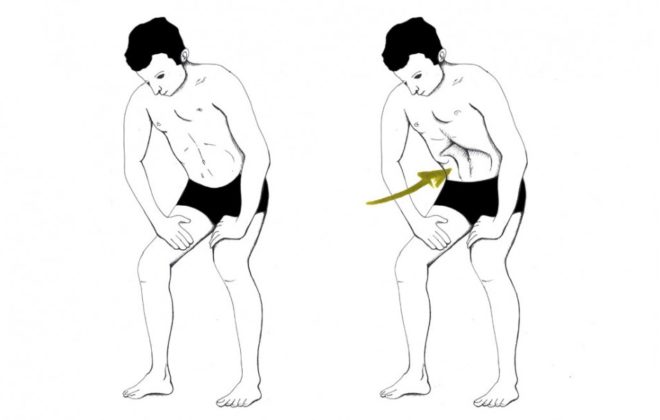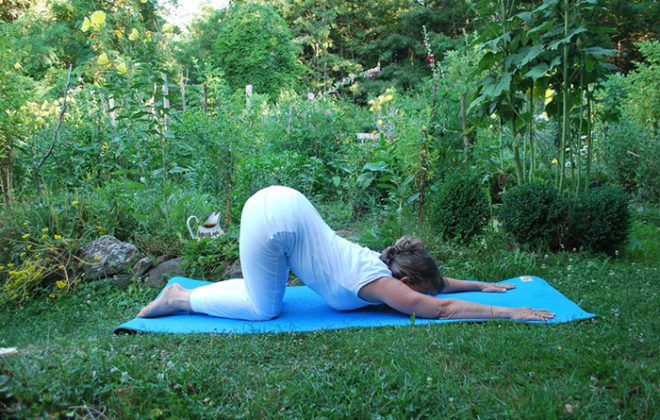The usefulness of yoga in case of cervical problems

YOGA, A VALID HELP TO RELIEVE SYMPTOMS, AND TREAT THE NECK
Surely almost everyone has already had a stiff neck and therefore we could experience the annoying neck pain. But during my courses I have been able to frequently see that many people suffer from chronic cervical pain, or even hernias or discopathies in this area. Caused by working at the desk, and wrong postures and even lack of, or insufficient exercise, the symptoms become chronic. Since the bone, vertebral and joint structure is kept elastic, flexible and mobile only through muscle chains, tendons and tonic and strong ligaments, it becomes clear that with regular yoga exercises, possibly daily, we can intervene in a very positive and lasting way.
Let’s see the exercises that are indicated:
Sit in a correct position with your torso straight
Make small movements of the head up and down, as if to say a “yes”; they move and heat the first cervical vertebra. If you want to check the movement, bringing your hands under the nape of the neck, apply a slight pressure with the fingertips, just where you feel a dip.
Small lateral movements of the head from right to left as if to say a “no” move and heat the second cervical vertebra; you can check the point by sliding your fingertips on the protruding apophysis.
A small flexion of the head downwards and the right shoulder, then downwards and the left shoulder, move and warm the third vertebra, which you can still verify with the pressure of your fingers.
The face that rotates until it is in profile right above the shoulder, to the right and to the left, benefits and warms the fourth vertebra. Turning the head to the right, relax the right arm to check the point with the fingers of the left hand, then relax the left arm to check with the right hand.
Push the chin forward and slightly upwards so that it stretches a little, simultaneously the shoulders backward, it benefits the fifth cervical vertebra.
Push again the chin upward until the neck is arched, turning the face to the sky, brings the heating action to the sixth vertebra.
Curving the neck to look down, until the chin touches the sternum, brings a cervical traction that mainly affects the seventh vertebra. With these simple movements, the neck is warmed up and all the cervical vertebrae are kept flexible, preventing arthrosis or preventing the advancement of arthritis processes if these are already in place. On a symbolic level, the movements of the seven vertebrae indicate the passing of days in a “finite cycle”, just as they indicate the days of the week, the musical notes, the fundamental colors of the light spectrum and the constellations.
Bring your left open hand to your ear and close to your head, keeping your elbow up and keeping your head and neck straight. As you inhale, forcefully push your hand against the counteracting thrust of your head, exhaling relax the part. Repeat the exercise three consecutive times on the left and then in the same manner and the same times on the right. This is Karna Pida mudrà, the gesture of the ear and pain. On a symbolic level, it indicates the possibility of yogis to close lateral listening, practically only listening to what they decide.
Bring both hands to support the chin. Keep your head straight on your neck, keep your shoulders back and inhaling energetically push your hands upwards to stretch your neck, while your head tries to counteract the gesture by weighing on your hands and pushing towards the ground. As you exhale, relax the part. During the push of the hands upwards, fingers and palms open to increase the strength of the joined wrists, while in the relaxation phase the fingers relax by touching the face. Repeat the exercise three consecutive times. This is Kusuma mudra, the gesture of the flower that blooms and grows. Symbolically it represents the possibility of spiritual growth: the Vishuddha Chakra is located in the throat, the “very pure” – “ethereal”, as its Sanskrit name indicates, and is precisely delegated to govern growth in the deepest sense of the term.
And here is the asana that brings enormous benefit to the neck, it is always worth performing it with due caution (therefore with a deep listening to our body), especially if there are discopathies in place:

SHASHA-ASANA, the hare
Sitting on the heels, during an exhalation flex the torso forward, so as to place the forearms on the ground, with the elbows on the sides of the knees. Pushing the chin up and simultaeously the shoulders back and down towards the ground. In case of major problems with the cervical, lengthen the sternum more by removing tension from the nape of the neck. Maintain this first phase of the asana for a few minutes

then, pressing the hands into the ground, extend the arms, push the chin even higher, even here it is valid same as in the first phase to stretch the sternum even more, and bring the shoulder blades together.

Maintaining this second phase for a while, afterwards inhaling we raise the pelvis and exhaling we place the top of the head between the hands on the ground and we shift the weight of the body forward. In this third phase the cervical area stretches and straightens and the throat closes slightly.
For further information read the book: The secrets of Yoga, by Gabriella Cella Al Chamali, page 49
I wish you a good practice
With gratitude
Sabine
Categories
- Senza categoria (10)



